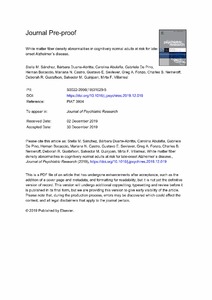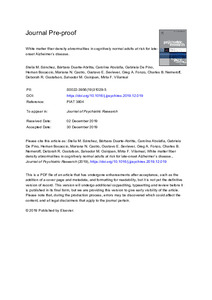Please use this identifier to cite or link to this item:
https://repositorio.uca.edu.ar/handle/123456789/10116| Título: | White matter fiber density abnormalities in cognitively normal adults at risk for lateonset Alzheimer´s disease | Autor: | Sánchez, Stella M. Duarte-Abritta, Bárbara Abulafia, Carolina Andrea De Pino, Gabriela Bocaccio, Hernan Castro, Mariana N. Sevlever, Gustavo Fonzo, Greg A. Nemeroff, Charles B. Gustafson, Deborah R. Guinjoan, Salvador M. Villarreal, Mirta F. |
Palabras clave: | ENFERMEDAD DE ALZHEIMER; ENFERMEDADES NEURODEGENERATIVAS; PREVENCION Y CONTROL; DIAGNOSTICO; TRATAMIENTO MEDICO; RESONANCIA MAGNETICA NUCLEAR; FUNCION COGNITIVA; EVALUACION NEUROPSICOLOGICA | Fecha de publicación: | 2019 | Editorial: | Elsevier | Cita: | Sánchez, S. M., et al. White matter fiber density abnormalities in cognitively normal adults at risk for lateonset Alzheimer´s disease [en línea]. Journal of Psychiatric Research. 2019, 122. doi:10.1016/j.jpsychires.2019.12.019. Disponible en: https://repositorio.uca.edu.ar/handle/123456789/10116 | Resumen: | Abstract: Tau accumulation affecting white matter tracts is an early neuropathological feature of late-onset Alzheimer’s disease (LOAD). There is a need to ascertain methods for the detection of early LOAD features to help with disease prevention efforts. The microstructure of these tracts and anatomical brain connectivity can be assessed by analyzing diffusion MRI (dMRI) data. Considering that family history increases the risk of developing LOAD, we explored the microstructure of white matter through dMRI in 23 cognitively normal adults who are offspring of patients with Late-Onset Alzheimer’s Disease (O-LOAD) and 22 control subjects (CS) without family history of AD. We also evaluated the relation of white matter microstructure metrics with cortical thickness, volumetry, in vivo amyloid deposition (with the help of PiB positron emission tomography -PiB-PET) and regional brain metabolism (as FDG-PET) measures. Finally we studied the association between cognitive performance and white matter microstructure metrics. O-LOAD exhibited lower fiber density and fractional anisotropy in the posterior portion of the corpus callosum and right fornix when compared to CS. Among O-LOAD, reduced fiber density was associated with lower amyloid deposition in the right hippocampus, and greater cortical thickness in the left precuneus, while higher mean diffusivity was related with greater cortical thickness of the right superior temporal gyrus. Additionally, compromised white matter microstructure was associated with poorer semantic fluency. In conclusion, white matter microstructure metrics may reveal early differences in O-LOAD by virtue of parental history of the disorder, when compared to CS without a family history of LOAD. We demonstrate that these differences are associated with lower fiber density in the posterior portion of the corpus callosum and the right fornix. | URI: | https://repositorio.uca.edu.ar/handle/123456789/10116 | ISSN: | 0022-3956 (online) | Disciplina: | MEDICINA | DOI: | 10.1016/j.jpsychires.2019.12.019 | Derechos: | Acceso abierto. 12 meses de embargo | Fuente: | Journal of Psychiatric Research. 2019, 122 |
| Appears in Collections: | Artículos |
Files in This Item:
| File | Description | Size | Format | |
|---|---|---|---|---|
| white-matter-fiber-density.jpg | 917,4 kB | JPEG |  View/Open | |
| white-matter-fiber-density.pdf | 2,56 MB | Adobe PDF |  View/Open |
Page view(s)
316
checked on Apr 30, 2024
Download(s)
592
checked on Apr 30, 2024
Google ScholarTM
Check
Altmetric
Altmetric
This item is licensed under a Creative Commons License

